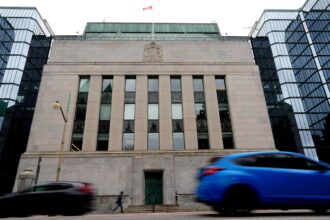In a closely watched announcement Thursday, Canada’s banking regulator maintained its domestic stability buffer at 3.5 percent, signaling continued caution amid lingering economic uncertainties despite some improving financial conditions.
The Office of the Superintendent of Financial Institutions (OSFI) held firm on the capital cushion that Canada’s six largest banks must maintain—a decision that comes as households continue navigating high interest rates and significant debt loads.
“The economic landscape remains precarious,” said OSFI Superintendent Peter Routledge during the announcement. “While we’ve seen modest improvements in some economic indicators, persistent inflation concerns and household debt vulnerabilities require maintaining strong capital reserves across our banking system.”
This marks the fourth consecutive review where OSFI has kept the buffer unchanged since raising it to 3.5 percent in December 2023. The decision requires BMO, CIBC, National Bank, RBC, Scotiabank, and TD to continue holding additional capital equivalent to 3.5 percent of their risk-weighted assets.
Financial markets had been divided on whether OSFI might reduce the buffer following Canada’s gradual economic improvement. However, the regulator cited “elevated and persistent vulnerabilities” in the financial system that outweighed positive developments.
Housing market stresses remain a primary concern, with mortgage renewals continuing to place pressure on household finances. Data shows approximately 39 percent of fixed-rate mortgages will face renewal within the next 18 months, with many homeowners bracing for significantly higher payments.
“We’re seeing a slight decrease in new insolvency filings, but the overall financial stress indicators remain above historical averages,” explained economist Maya Henderson with the Canadian Financial Research Institute. “OSFI is essentially saying this isn’t the time to reduce safety margins.”
The domestic stability buffer, introduced in 2018, serves as a countercyclical tool designed to be built up during stable periods and drawn down during stress. Unlike other capital requirements, banks can temporarily dip into this buffer during financial distress without regulatory penalties.
The decision aligns with the Bank of Canada’s cautious approach to monetary policy, which has seen interest rates held steady for three consecutive meetings as inflation gradually moderates. Market analysts from CO24 Business note this coordinated conservatism suggests regulators remain concerned about potential economic shocks.
“What’s notable here is that OSFI isn’t yet seeing enough improvement to begin unwinding the buffer,” said Jonathan Chen, banking analyst at West Coast Capital Markets. “This suggests they anticipate continued stress in the system through at least the end of 2025.”
Interestingly, Canada’s major banks have been maintaining capital levels well above regulatory minimums, with Common Equity Tier 1 ratios averaging nearly 13 percent across the Big Six in their most recent quarterly reports. This excess capital has allowed continued dividend increases despite the elevated buffer requirements.
Banking industry representatives expressed understanding of OSFI’s decision while emphasizing the sector’s strength. “Canadian banks remain among the world’s best capitalized,” said Canadian Bankers Association spokesperson Elaine Wong. “This conservative approach has served our financial system well through multiple economic cycles.”
OSFI reviews the domestic stability buffer semi-annually, with the next decision scheduled for December. Market observers from CO24 Breaking News will be watching closely for any shift in language that might signal a future reduction.
As both households and financial institutions navigate this extended period of high interest rates, the stability buffer decision underscores a fundamental reality: Canada’s financial regulators are taking no chances with the resilience of our banking system, even as they acknowledge gradual economic improvement.










